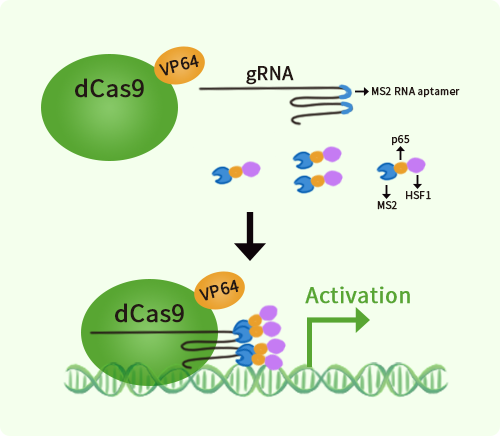Human TFIP11 activation kit by CRISPRa
CAT#: GA108512
TFIP11 CRISPRa kit - CRISPR gene activation of human tuftelin interacting protein 11
Find the corresponding CRISPRi Inhibitor Kit
USD 1,290.00
2 Weeks*
Specifications
| Product Data | |
| Format | 3gRNAs, 1 scramble ctrl and 1 enhancer vector |
| Symbol | TFIP11 |
| Locus ID | 24144 |
| Kit Components | GA108512G1, TFIP11 gRNA vector 1 in pCas-Guide-CRISPRa GA108512G2, TFIP11 gRNA vector 2 in pCas-Guide-CRISPRa GA108512G3, TFIP11 gRNA vector 3 in pCas-Guide-CRISPRa 1 CRISPRa-Enhancer vector, SKU GE100056 1 CRISPRa scramble vector, SKU GE100058 |
| Disclaimer | The kit is designed based on the best knowledge of CRISPa SAM technology. The efficiency of the activation can be affected by many factors, including nucleosome occupancy status, chromatin structure and the gene expression level of the target, etc. |
| Reference Data | |
| RefSeq | NM_001008697, NM_012143, NM_001346857, NM_001346858, NM_001346859, NM_001346861, NM_001346862 |
| Synonyms | bK445C9.6; hNtr1; NTR1; Spp382; TIP39 |
| Summary | This gene encodes a protein component of the spliceosome that promotes the release of the lariat-intron during late-stage splicing through the recruitment of a pre-mRNA splicing factor called DEAH-box helicase 15. The encoded protein contains a G-patch domain, a hallmark of RNA-processing proteins, that binds DEAH-box helicase 15. This protein contains an atypical nuclear localization sequence as well as a nuclear speckle-targeting sequence, enabling it to localize to distinct speckled regions within the cell nucleus. Polymorphisms in this gene are associated with dental caries suggesting a role in amelogenesis. Alternative splicing results in multiple transcript variants. [provided by RefSeq, Nov 2016] |
Documents
| Product Manuals |
| FAQs |
| SDS |
Resources
Other Versions
| SKU | Description | Size | Price |
|---|---|---|---|
| KN400290 | TFIP11 - KN2.0, Human gene knockout kit via CRISPR, non-homology mediated. |
USD 1,290.00 |
{0} Product Review(s)
Be the first one to submit a review






























































































































































































































































 Germany
Germany
 Japan
Japan
 United Kingdom
United Kingdom
 China
China
